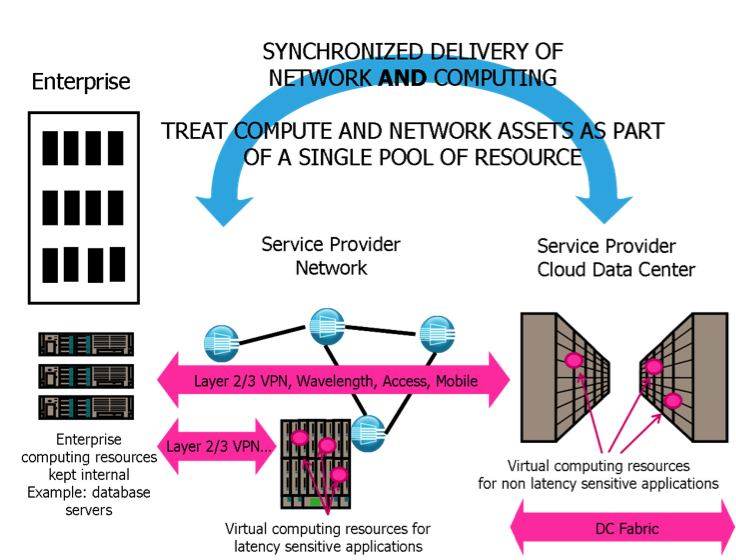Carrier cloud
Carrier cloud is class of cloud computing service that merges the high-performance capabilities and reliability of a communications service provider's network with the lower costs and flexibility provided by traditional public cloud services. The carrier cloud attempts to remove the data bottleneck and security issues that often occur in and to the virtualized data center due to lack of control of data flow over the public Internet.[1][2]
History
By the beginning of the twenty-first century, the advent of virtualization technology and cost effective computing hardware, as well as ubiquitous Internet connectivity, enabled a first wave of cloud services, including Salesforce.com in 1999 and Amazon Web Services in 2002.[3] However, many businesses and organizations hesitated to move more demanding applications from on-premise dedicated hardware into public or private clouds. As a response, communications service providers (CSPs) started around 2009 to develop carrier clouds that address perceived weaknesses in existing cloud services.[4][5] Weaknesses cited vary but often include performance, availability, security, and service level agreements (SLAs).[6][7]
By 2012, carrier cloud was becoming more notable, with the Carrier Cloud Summit taking place in Paris, France[8] and the Carrier Cloud Telecoms initiative between Intel and Tieto exploring the research and development challenges for CSPs in the cloud computing domain.[9] And in September 2013, communications and research business LightReading announced it would include the new category of "Most Innovative Carrier Cloud Service" in its annual Leading Lights awards "to recognize the growing focus in the communication service provider (CSP) sector on cloud services and the ways in which CSPs are innovating in this realm."[10]
Carrier cloud vs. public cloud
Carrier cloud service is similar to public cloud service in that infrastructures are converged into a single, optimized computing package, and services are shared across a group or organization. Carrier cloud service, however, utilizes the existing and upgraded network structures of the CSP to provide end-to-end services over their own network. Since the CSP more readily controls the data flow through its content delivery networks and/or dedicated virtual private networks, it can better manage issues with bandwidth, latency, and jitter.[1][9] Additional "last mile" carrier-grade services already provided by CSPs in cities also "offset the latencies associated with cross-country or inter-continental backhaul."[1] Additionally, because the CSP uses carrier-grade equipment — which meets or exceeds "five nines" (99.999%) high availability standards and provides very fast fault recovery through redundancy — reliability is built in from end-to-end.[1] The carrier cloud also adds security, with its wide area network providing segregated encrypted or unencrypted network links that are not accessible from the general Internet and its data center providing virtual private servers, management processes, logs, and documentation to fulfill security and governance rules.[1][9] This may include adhering to privacy and other types of regulations that mandate certain types of data must not be sent outside a national jurisdiction or other geographical region.[11]
Notes
An element or two of this article is reused from the Wikipedia article.
References
- ↑ 1.0 1.1 1.2 1.3 1.4 "Cloud Evolution: The Carrier Cloud" (PDF). Kontron. 2013. http://www.kontron.com/resources/collateral/white_papers/kontroncarriercloudwp.pdf.
- ↑ Narcisi, Gina (November 2013). "Carrier cloud services: Do customers care if you own the network?". SearchTelecom. TechTarget. http://searchtelecom.techtarget.com/feature/Carrier-cloud-services-Do-customers-care-if-you-own-the-network. Retrieved 20 August 2014.
- ↑ Mohamed, Arif (March 2009). "A history of cloud computing". ComputerWorld.com. TechTarget. http://www.computerweekly.com/feature/A-history-of-cloud-computing. Retrieved 20 August 2014.
- ↑ Scarpati, Jessica (8 October 2009). "Carriers poised to offer cloud computing services, but with some risks". SearchTelecom. TechTarget. http://searchtelecom.techtarget.com/news/1370739/Carriers-poised-to-offer-cloud-computing-services-but-with-some-risks. Retrieved 20 August 2014.
- ↑ Scarpati, Jessica (8 October 2009). "Telecom cloud services change hosting business model". SearchTelecom. TechTarget. http://searchtelecom.techtarget.com/news/1370759/Telecom-cloud-services-change-hosting-business-model. Retrieved 20 August 2014.
- ↑ Jansen, Wayne; Grance, Timothy (January 2011). "Guidelines on Security and Privacy in Public Cloud Computing" (PDF). National Institute of Standards and Technology. https://downloads.cloudsecurityalliance.org/initiatives/guidance/NIST-Draft-SP-800-144_cloud-computing.pdf. Retrieved 20 August 2014.
- ↑ Kim, Jeff (21 April 2011). "Performance issues cloud content delivery options". ECM Plus. http://ecmplus.wordpress.com/2011/04/21/feature-performance-issues-cloud-content-deliverey-options/. Retrieved 20 August 2014.
- ↑ "Carrier Cloud Summit 2012". Upperside Conferences. 2012. http://www.uppersideconferences.com/carriercloud2012/carriercloud2012intro.html. Retrieved 20 August 2014.
- ↑ 9.0 9.1 9.2 "Carrier Cloud Telecoms - Exploring the Challenges of Deploying Virtualisation and SDN in Telecoms Networks" (PDF). Intel Corporation. 2013. http://www.tieto.com/sites/default/files/atoms/files/carrier-cloud-telecoms-whitepaper.pdf. Retrieved 20 August 2014.
- ↑ Wilson, Carol (13 September 2013). "2013 Leading Lights Finalists: Most Innovative Carrier Cloud Service". LightReading. http://www.lightreading.com/services-apps/cloud-services/2013-leading-lights-finalists-most-innovative-carrier-cloud-service/d/d-id/705653. Retrieved 20 August 2014.
- ↑ "Considerations for Carrier Grade Clouds: Security". Valbonne Consulting. 13 August 2014. http://valbonneconsulting.wordpress.com/2014/08/13/considerations-for-carrier-grade-clouds-security/. Retrieved 20 August 2014.










